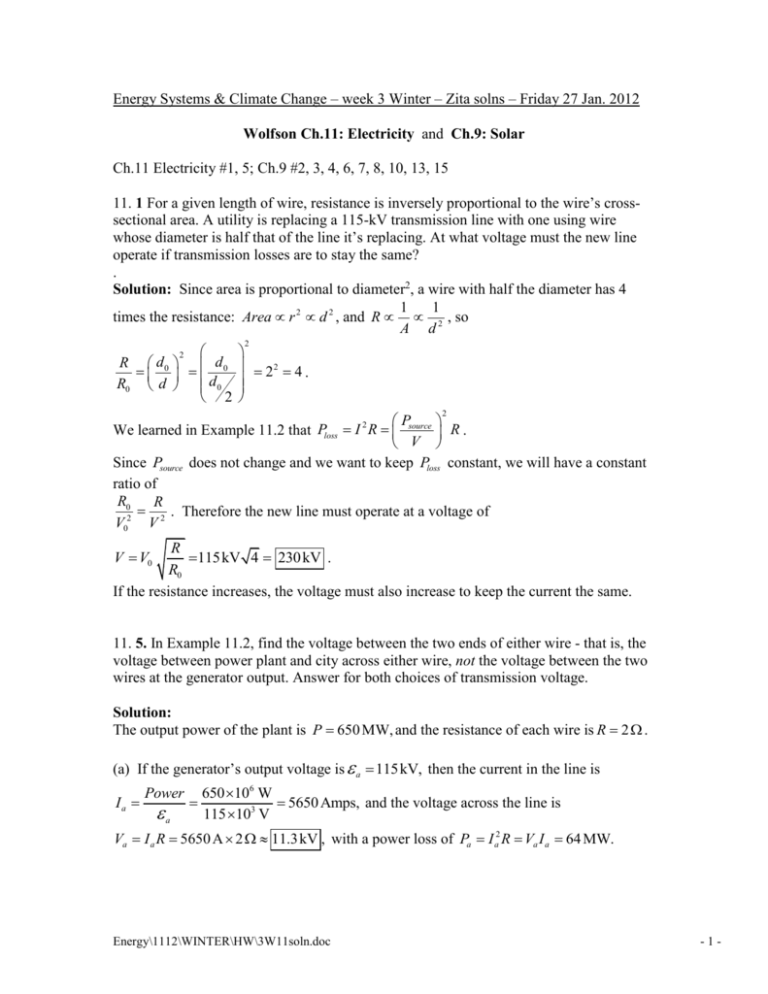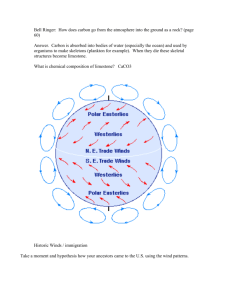Energy Systems & Climate Change – week 3 Winter – Zita solns
advertisement

Energy Systems & Climate Change – week 3 Winter – Zita solns – Friday 27 Jan. 2012 Wolfson Ch.11: Electricity and Ch.9: Solar Ch.11 Electricity #1, 5; Ch.9 #2, 3, 4, 6, 7, 8, 10, 13, 15 11. 1 For a given length of wire, resistance is inversely proportional to the wire’s crosssectional area. A utility is replacing a 115-kV transmission line with one using wire whose diameter is half that of the line it’s replacing. At what voltage must the new line operate if transmission losses are to stay the same? . Solution: Since area is proportional to diameter2, a wire with half the diameter has 4 1 1 times the resistance: Area r 2 d 2 , and R 2 , so A d R d0 d0 R0 d d 0 2 2 2 22 4 . 2 P We learned in Example 11.2 that Ploss I R source R . V Since Psource does not change and we want to keep Ploss constant, we will have a constant ratio of R0 R 2 . Therefore the new line must operate at a voltage of 2 V0 V 2 R 115kV 4 230 kV . R0 If the resistance increases, the voltage must also increase to keep the current the same. V V0 11. 5. In Example 11.2, find the voltage between the two ends of either wire - that is, the voltage between power plant and city across either wire, not the voltage between the two wires at the generator output. Answer for both choices of transmission voltage. Solution: The output power of the plant is P 650 MW, and the resistance of each wire is R 2 . (a) If the generator’s output voltage is a 115kV, then the current in the line is Ia Power a 650 106 W 5650 Amps, and the voltage across the line is 115 103 V Va I a R 5650 A 2 11.3kV , with a power loss of Pa I a2 R Va I a 64 MW. Energy\1112\WINTER\HW\3W11soln.doc -1- (b) If the generator’s output voltage is b 345kV, then the current in the line is Ib Power b 650 106 W 1880 Amps, and the voltage across the line is 345 103 V Vb I b R 1880 A 2 3.8 kV , with a power loss of Pb I b2 R Vb I b 7 MW. Solar: Ch.9 #2, 3, 4, 6, 7, 8, 10, 13, 15 2. Use the values of Earth’s radius and the solar constant given in the text to verify the figure 174 PW for the total solar power incident on Earth’s sunward side. Solution: Earth intercepts solar radiation effectively as a flat disk of radius RE 6.37106 m. 2 Power Power from Sun = disk area = S RE 2 1364 W 2 6.37 106 m 1.74 1017 W m Area Power from Sun 174 PW 3. How long does it take the Sun to deliver to Earth the total amount of energy humankind uses in a year? Solution: Power energy / time. First find how much energy people use in a year, if we use power Pp = 16 TW. J Annual energy use = power time = Pp 1 year 16 1012 107 s 5 1020 J s Now we can find the time it takes the Sun to deliver this much energy: energy used by people 5.0 1020 J min time = 2.9 103 s 48 minutes 17 J power from Sun 60 s 1.74 10 s 4. A passive solar house requires an average heating power of 8.4 kW in the winter. It stores energy in 10 tonnes (10,000 kg) of Glauber salt, whose heat of fusion is 241 kJ/kg. At the end of a sunny stretch, the Glauber salt is all liquid at its 32C melting point. If the weather then turns cloudy for a prolonged period, how long will the Glauber salt stay at 32C and thus keep the house comfortable? Solution: The salt’s temperature won’t change as it solidifies, since freezing is a phase transition. The heat energy required to solidify the salt is Q mL, and the time this takes can be found in the relation between power and energy: Energy\1112\WINTER\HW\3W11soln.doc -2- energy Q mL , therefore time t t 4 3 J mL 10 24110 kg hr time = 2.87 105 s 80 hr = 3.3 days 3 J P 3, 600s 8.4 10 s power = 6. A household uses 100 gallons of hot water per day (1 gallon of water has a mass of 3.78 kg), and the water temperature must be raised from 10˚C to 50˚C. (a) Find the average power needed to heat the water. (b) Then assume you have solar collectors with e = 55% average efficiency at converting sunlight to thermal energy when tilted at your location’s latitude. Use data from Table 9.1 to find the collector area needed to supply this power in Albuquerque in June. Solution: The energy needed to heat water is Q mC T, where the specific heat of 3.78 kg water c 4184 J/kgK, the mass of water is m 100 gallons 378 kg, and the gallons temperature change T 50C – 10C = 40C 40 K. (a) The average power needed to heat the water energy mc T is power time one day 378 kg 4184 J kg K 3, 600 s 24 hr hr 40 K 732 W (b) The average horizontal insolation in Albuquerque in June is S = 296 W/m2 = power / power 732 W 4.5 m 2 . area, so the required area of solar panels is: area eS 0.55 296 W 2 m 7. Repeat part (b) of the preceding problem for Minneapolis in January, assuming a lower efficiency of e = 32% (because of higher losses at the lower temperature). Solution: The average horizontal insolation in Minneapolis in January is S 146 W/m2, power 732 W 16 m 2 . so the required area of solar panels is area e S 0.32 146 W 2 m 8. Find the average temperature in the passive solar house of Example 9.2 if it’s located in (a) Fairbanks and (b) San Francisco. Solution: First recall the analysis of Example 9.2: Heat loss through walls and roof QWR 120 T (W/C), where T Tin Tout Energy\1112\WINTER\HW\3W11soln.doc -3- Heat loss through windows (glazing) QG A windows T 34 T (W/C) R Total heat loss Qout QWR QG 154 T (W/C) Heat gain from Sun onto floor Qin Afloor S 39 S (W), where S depends on latitude Our strategy for each location is to look up S and the average outdoor temperature for a given month, and calculate the temperature from the equilibrium condition: Qin Qout 39 S (W) 154 T (W/C) 39 S T C Tin Tout 154 (a) For Fairbanks in January, the average outdoor temperature is Tout –23.4C and the insolation (for solar panels tilted at latitude) is S 4 W/m2. Therefore, 39 4 156 T C 1.01C and the average January temperature is: 154 154 Tin Tout T 23.4C 1C 22.4C (this is too cold!) (b) For San Francisco in January, the average outdoor temperature is Tout 9.3C and the insolation (for solar panels tilted at latitude) is S 92 W/m2. Therefore, 39 92 3,590 T C 23.3C and the average January temperature is: 154 154 Tin Tout T 9.3C 23.3C 32.6C (this is too warm!) 10. My college’s average electric power consumption is about 2 MW. What area of 15% efficient PV modules would be needed to supply this power during a summer month when insolation on the modules averages 225 W/m2? Compare with the area of the college’s football field (55 m by 110 m overall). Solution: One football field has an area of 55 m 110 m = 6 103 m 2 . The PV modules’ effective insolation = power / area, so P 2 106 W 6 104 m 2 or the area required = e S 0.15 225 W 2 m 60 thousand square meters, which is about 10 football fields. Energy\1112\WINTER\HW\3W11soln.doc -4- 13. A solar hot-water system for a U.S. home costs about $6,000 after government subsides. If the system reduces electrical energy consumption by 3,500 kWh of electrical energy each year, and if electricity costs 14¢/kWh, how long will the system take to pay for itself (neglect the economics of borrowed money and similar complications). Solution: What is the rate of energy savings? Energy savings 3500 kW h $0.14 $490 Savings rate year year energy year kW h How long will it take to pay for the cost of the system? Cost $6000 Payback time 12 years . savings rate $490 year Plus, the system is preventing CO2 emissions for water heating supplied by coal plants or other fossil fuel burning. 15. The controversial Cheviot open-pit coal mine in Alberta, Canada, occupies 7,455 hectares and produces 1.4 million tonnes (1 tonne = 1,000 kg) of coal per year. (a) Use the energy content of coal from Table 3.3 to find the power in watts corresponding to this rate of coal production, assuming it’s burned in power plants with 35% efficiency. (b) Again using the assumptions of Example 9.4, find the area of a PV plant with this power output, and compare that number with the area of the Cheviot mine. Solution: To find how big a PV plant we would need to replace this coal mine, first let’s find out how much power this mine produces. Recall (Table 3.3) that coal produces dE MJ approximately . 29 dm kg (a) The power produced is: 6 3 dE dE dm J 6 J 1.4 10 10 kg Pcoal e e 0.35 29 10 4.5 108 450 MW 7 dt dm dt kg s 10 s year year (b) The solar PV power produced is the efficiency insolation area: Psolar e S A . In order to have Psolar Pcoal , the required PV area would be 2A: e S A Pcoal 2A 2 Pcoal 2 4.5 108 W ha 2.36 107 m 2 4 2 2,360 ha eS 10 m 0.15 254 W 2 m The solar PV array requires only about 2,360 32% the area of the Cheviot mine to 7, 455 generate the same amount of power. Energy\1112\WINTER\HW\3W11soln.doc -5-





